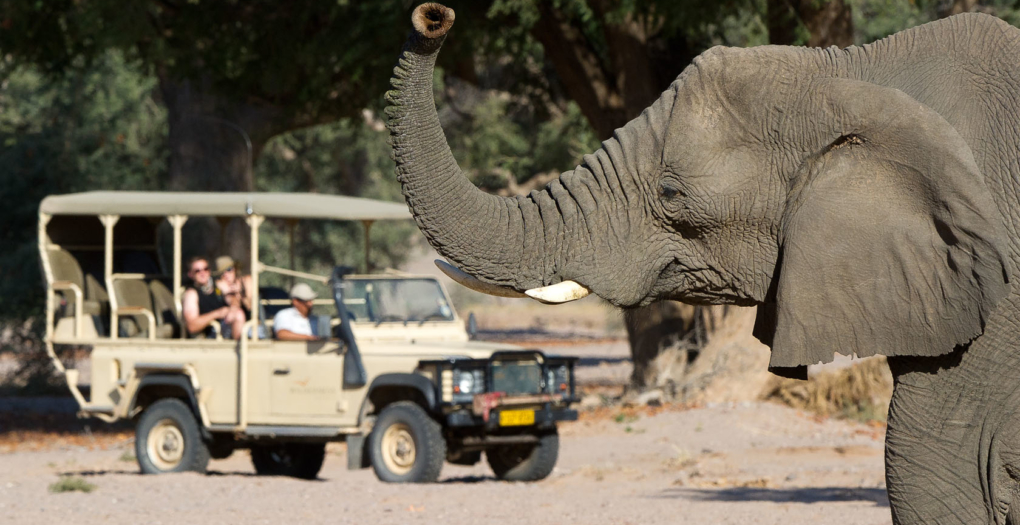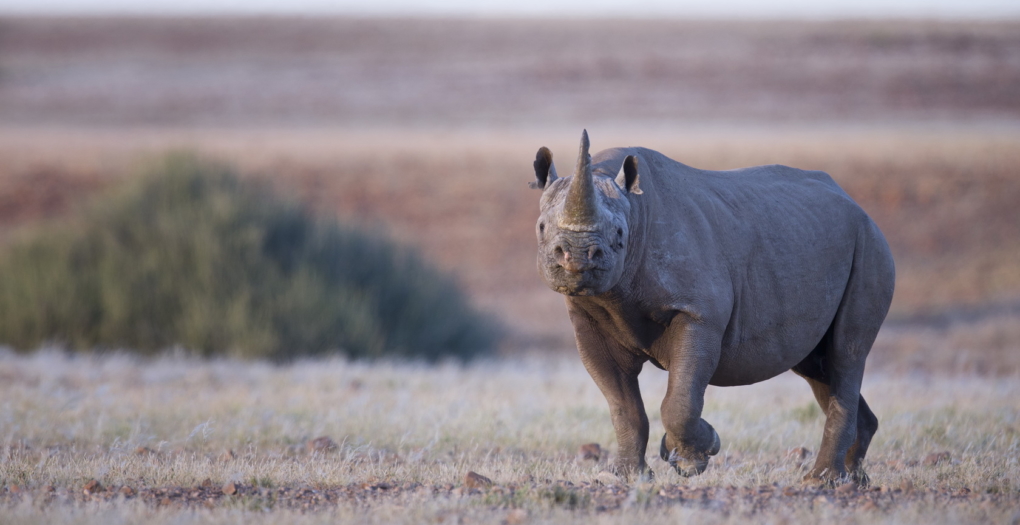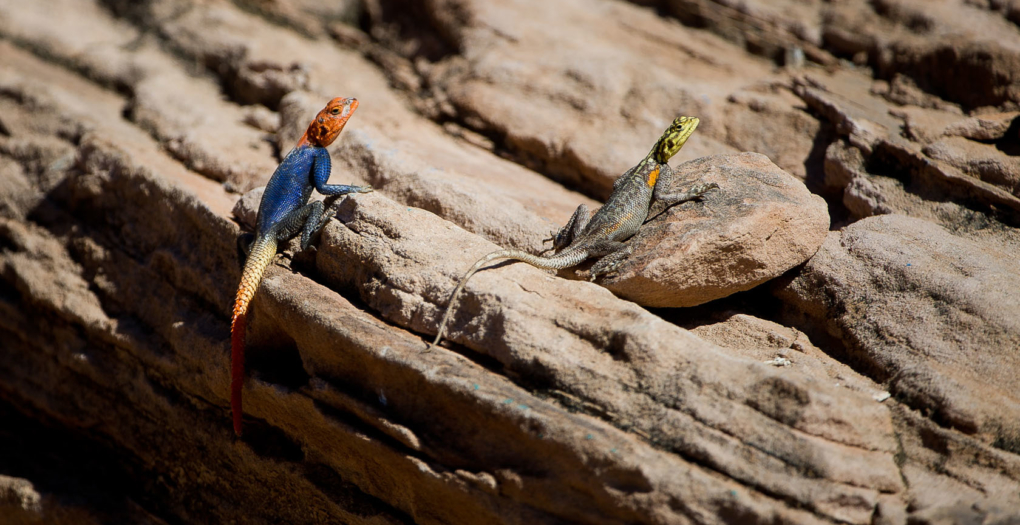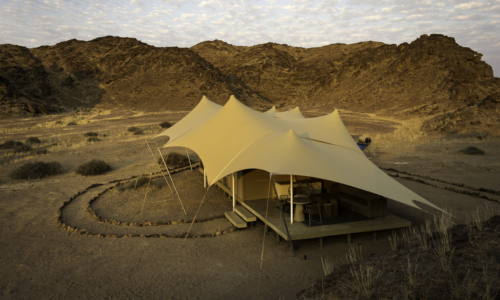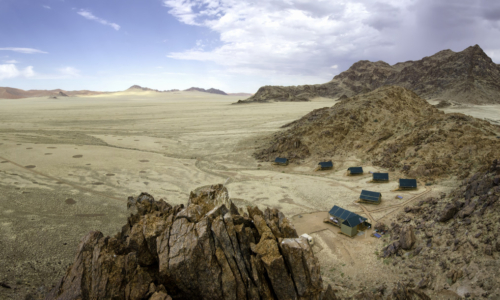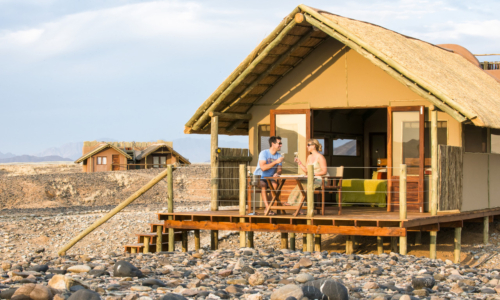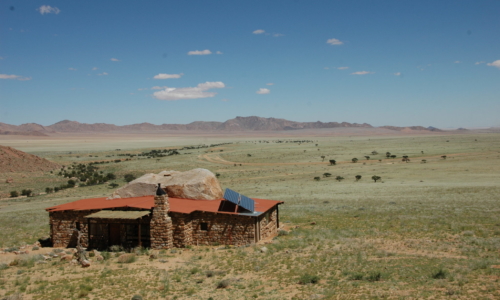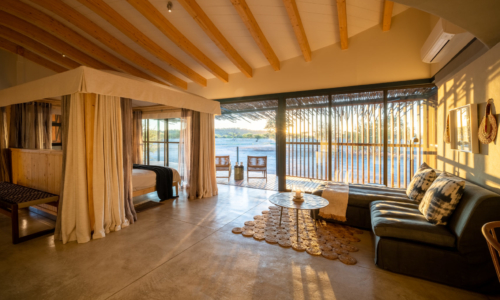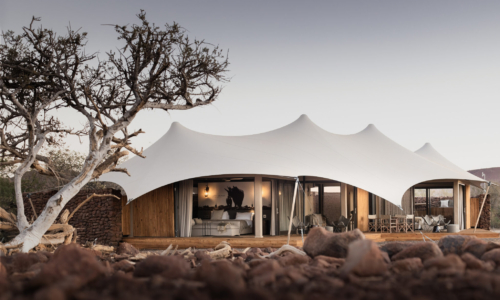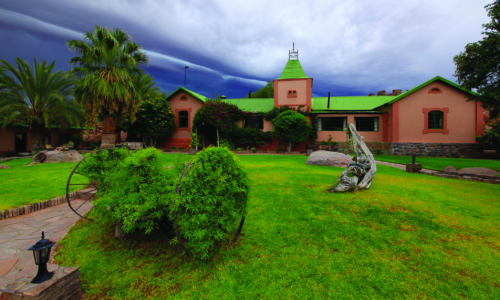The region of Damaraland is the old apartheid name given to the region north of Swakopmund and the Damara people who were relocated to the region in the 1960s. It extends 124 miles inland from the desolate Skeleton Coast and 372 miles southwards from Kaokoland. The Damara people still live in the region and together with the San Bushmen are the oldest inhabitants of Namibia. Though the majority of the region is uninhabited due to its arid climate and rugged geography.
The landscape here consists of open plains and grassland, massive granite kopies, and deep gorges. While in the west, the geography changes into sandy wasteland. The Brandberg is not only the highest mountain in Namibia, it is home to the white lady bushmen paintings. Whereas Twyfelfontein is famous for its 2,000 rock carvings made by ancient Bushmen. Then there is the Petrified Forest of the Khorixas area, the Organ Pipes which are a distinctive series of dolerite pillars, and Burnt Mountain for its blackened limestone base.
While the blistering hot and arid landscape is not hospitable to a large number of animals, Damaraland is home to several desert-adapted species. Because water is scarce, the elephants and black rhinos who live here can go for days without water. The elephants move through euphorbia bush country, and can travel up to forty-three miles in a day in search of food and water. Gemsbok, kudu, springbok, Hartman’s mountain zebra, southern giraffe, gemsbok, lion, cheetah, and spotted and brown hyena call this desert home too. In the mountains around Palmwag, Etendeka, and Damaraland Camp, there are resident steenbok, baboon, kudu, porcupine, and the occasional klipspringer and warthog. Birdwatchers will delight in the over 240 species recorded here.
Game drives in Damaraland are offered at most of the local safari camps and lodges. However, most of these game drives specialize in tracking the unique desert-adapted elephants while enjoying the dramatic scenery from the vantage point of a comfortable 4×4 safari vehicle and the knowledge of a local guide. Other guided excursions travel to Twyfelfontein, Brandberg, Organ Pipes, and Burnt Mountain. Hikers and climbers love the region for its ruggedness. There are some marked hiking trails around the lodges. While climbers enjoy the challenge of conquering Brandberg Mountain.

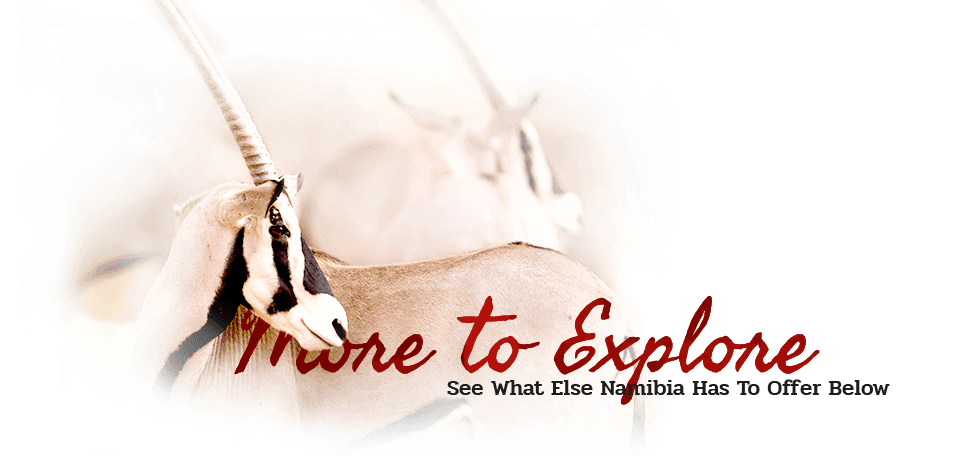
- Anderssons at Ongava
- Babson House
- Camp Kipwe
- Canyon Lodge
- Canyon Roadhouse
- Canyon Village
- Cape Cross Lodge
- Chobe Savanna Lodge
- Damara Mopane Lodge
- Damaraland Camp
- Dead Valley Lodge
- Desert Hills Glamping Camp
- Desert Homestead
- Desert Homestead Outpost
- Desert Rhino Camp
- Dolomite Camp
- Doro Nawas Camp
- Eagle’s Nest Lodge
- Erongo Wilderness Lodge
- Etosha Heights Safari House
- Etosha Mountain Lodge
- Etosha Safari Camp
- Etosha Safari Lodge
- Fish River Lodge
- Fort Sesfontein Lodge
- Grootberg Lodge
- Halali Camp
- Hoanib Elephant Camp
- Hoanib Skeleton Coast Camp
- Hoanib Valley Camp
- Ichingo Chobe River Lodge
- Kalahari Anib Lodge
- Kalahari Farmhouse
- Khorixas Rest Camp
- Kulala Desert Lodge
- Kwessi Dunes
- Little Kulala
- Little Ongava
- Malansrus Tented Camp
- Mowani Mountain Camp
- Mushara Bush Camp
- Mushara Lodge
- Mushara Outpost
- Naankuse Lodge
- Namib Desert Lodge
- Namushasha River Lodge
- Namutoni Camp
- Nhoma Safari Camp
- Nkasa Linyanti
- Okahirongo Elephant Lodge
- Okahirongo River Camp
- Okaukuejo Camp
- Okonjima Bush Camp
- Okonjima Bush Suite
- Okonjima Grand African Villa
- Okonjima Plains Camp
- Onduli Ridge
- Ongava Lodge
- Ongava Tented Camp
- Onguma Bush Camp
- Onguma Etosha Aoba Lodge
- Onguma Tented Camp
- Onguma The Fort
- Onguma Tree Top Camp
- Onkoshi Camp
- Ozondjou Trails
- Popa Falls Camp
- River Crossing Lodge
- Safarihoek Lodge
- Serra Cafema Camp
- Shipwreck Lodge
- Sossus Dune Lodge
- Sossusvlei Desert Lodge
- Terrace Bay Camp
- Teufelskrallen Tented Lodge
- Villa Mushara
- Wolwedans Boulders Camp
- Wolwedans Desert Lodge
- Wolwedans Dune Camp
- Wolwedans Mountain View Suite
- Wolwedans Plains Camp
- Anderssons at Ongava
- Babson House
- Camp Kipwe
- Canyon Lodge
- Canyon Roadhouse
- Canyon Village
- Cape Cross Lodge
- Chobe Savanna Lodge
- Damara Mopane Lodge
- Damaraland Camp
- Dead Valley Lodge
- Desert Hills Glamping Camp
- Desert Homestead
- Desert Homestead Outpost
- Desert Rhino Camp
- Dolomite Camp
- Doro Nawas Camp
- Eagle’s Nest Lodge
- Erongo Wilderness Lodge
- Etosha Heights Safari House
- Etosha Mountain Lodge
- Etosha Safari Camp
- Etosha Safari Lodge
- Fish River Lodge
- Fort Sesfontein Lodge
- Grootberg Lodge
- Halali Camp
- Hoanib Elephant Camp
- Hoanib Skeleton Coast Camp
- Hoanib Valley Camp
- Ichingo Chobe River Lodge
- Kalahari Anib Lodge
- Kalahari Farmhouse
- Khorixas Rest Camp
- Kulala Desert Lodge
- Kwessi Dunes
- Little Kulala
- Little Ongava
- Malansrus Tented Camp
- Mowani Mountain Camp
- Mushara Bush Camp
- Mushara Lodge
- Mushara Outpost
- Naankuse Lodge
- Namib Desert Lodge
- Namushasha River Lodge
- Namutoni Camp
- Nhoma Safari Camp
- Nkasa Linyanti
- Okahirongo Elephant Lodge
- Okahirongo River Camp
- Okaukuejo Camp
- Okonjima Bush Camp
- Okonjima Bush Suite
- Okonjima Grand African Villa
- Okonjima Plains Camp
- Onduli Ridge
- Ongava Lodge
- Ongava Tented Camp
- Onguma Bush Camp
- Onguma Etosha Aoba Lodge
- Onguma Tented Camp
- Onguma The Fort
- Onguma Tree Top Camp
- Onkoshi Camp
- Ozondjou Trails
- Popa Falls Camp
- River Crossing Lodge
- Safarihoek Lodge
- Serra Cafema Camp
- Shipwreck Lodge
- Sossus Dune Lodge
- Sossusvlei Desert Lodge
- Terrace Bay Camp
- Teufelskrallen Tented Lodge
- Villa Mushara
- Wolwedans Boulders Camp
- Wolwedans Desert Lodge
- Wolwedans Dune Camp
- Wolwedans Mountain View Suite
- Wolwedans Plains Camp

The region of Damaraland is the old apartheid name given to the region north of Swakopmund and the Damara people who were relocated to the region in the 1960s. It extends 124 miles inland from the desolate Skeleton Coast and 372 miles southwards from Kaokoland. The Damara people still live in the region and together with the San Bushmen are the oldest inhabitants of Namibia. Though the majority of the region is uninhabited due to its arid climate and rugged geography.
The landscape here consists of open plains and grassland, massive granite kopies, and deep gorges. While in the west, the geography changes into sandy wasteland. The Brandberg is not only the highest mountain in Namibia, it is home to the white lady bushmen paintings. Whereas Twyfelfontein is famous for its 2,000 rock carvings made by ancient Bushmen. Then there is the Petrified Forest of the Khorixas area, the Organ Pipes which are a distinctive series of dolerite pillars, and Burnt Mountain for its blackened limestone base.
While the blistering hot and arid landscape is not hospitable to a large number of animals, Damaraland is home to several desert-adapted species. Because water is scarce, the elephants and black rhinos who live here can go for days without water. The elephants move through euphorbia bush country, and can travel up to forty-three miles in a day in search of food and water. Gemsbok, kudu, springbok, Hartman’s mountain zebra, southern giraffe, gemsbok, lion, cheetah, and spotted and brown hyena call this desert home too. In the mountains around Palmwag, Etendeka, and Damaraland Camp, there are resident steenbok, baboon, kudu, porcupine, and the occasional klipspringer and warthog. Birdwatchers will delight in the over 240 species recorded here.
Game drives in Damaraland are offered at most of the local safari camps and lodges. However, most of these game drives specialize in tracking the unique desert-adapted elephants while enjoying the dramatic scenery from the vantage point of a comfortable 4×4 safari vehicle and the knowledge of a local guide. Other guided excursions travel to Twyfelfontein, Brandberg, Organ Pipes, and Burnt Mountain. Hikers and climbers love the region for its ruggedness. There are some marked hiking trails around the lodges. While climbers enjoy the challenge of conquering Brandberg Mountain.

- Anderssons at Ongava
- Babson House
- Camp Kipwe
- Canyon Lodge
- Canyon Roadhouse
- Canyon Village
- Cape Cross Lodge
- Chobe Savanna Lodge
- Damara Mopane Lodge
- Damaraland Camp
- Dead Valley Lodge
- Desert Hills Glamping Camp
- Desert Homestead
- Desert Homestead Outpost
- Desert Rhino Camp
- Dolomite Camp
- Doro Nawas Camp
- Eagle’s Nest Lodge
- Erongo Wilderness Lodge
- Etosha Heights Safari House
- Etosha Mountain Lodge
- Etosha Safari Camp
- Etosha Safari Lodge
- Fish River Lodge
- Fort Sesfontein Lodge
- Grootberg Lodge
- Halali Camp
- Hoanib Elephant Camp
- Hoanib Skeleton Coast Camp
- Hoanib Valley Camp
- Ichingo Chobe River Lodge
- Kalahari Anib Lodge
- Kalahari Farmhouse
- Khorixas Rest Camp
- Kulala Desert Lodge
- Kwessi Dunes
- Little Kulala
- Little Ongava
- Malansrus Tented Camp
- Mowani Mountain Camp
- Mushara Bush Camp
- Mushara Lodge
- Mushara Outpost
- Naankuse Lodge
- Namib Desert Lodge
- Namushasha River Lodge
- Namutoni Camp
- Nhoma Safari Camp
- Nkasa Linyanti
- Okahirongo Elephant Lodge
- Okahirongo River Camp
- Okaukuejo Camp
- Okonjima Bush Camp
- Okonjima Bush Suite
- Okonjima Grand African Villa
- Okonjima Plains Camp
- Onduli Ridge
- Ongava Lodge
- Ongava Tented Camp
- Onguma Bush Camp
- Onguma Etosha Aoba Lodge
- Onguma Tented Camp
- Onguma The Fort
- Onguma Tree Top Camp
- Onkoshi Camp
- Ozondjou Trails
- Popa Falls Camp
- River Crossing Lodge
- Safarihoek Lodge
- Serra Cafema Camp
- Shipwreck Lodge
- Sossus Dune Lodge
- Sossusvlei Desert Lodge
- Terrace Bay Camp
- Teufelskrallen Tented Lodge
- Villa Mushara
- Wolwedans Boulders Camp
- Wolwedans Desert Lodge
- Wolwedans Dune Camp
- Wolwedans Mountain View Suite
- Wolwedans Plains Camp
- Anderssons at Ongava
- Babson House
- Camp Kipwe
- Canyon Lodge
- Canyon Roadhouse
- Canyon Village
- Cape Cross Lodge
- Chobe Savanna Lodge
- Damara Mopane Lodge
- Damaraland Camp
- Dead Valley Lodge
- Desert Hills Glamping Camp
- Desert Homestead
- Desert Homestead Outpost
- Desert Rhino Camp
- Dolomite Camp
- Doro Nawas Camp
- Eagle’s Nest Lodge
- Erongo Wilderness Lodge
- Etosha Heights Safari House
- Etosha Mountain Lodge
- Etosha Safari Camp
- Etosha Safari Lodge
- Fish River Lodge
- Fort Sesfontein Lodge
- Grootberg Lodge
- Halali Camp
- Hoanib Elephant Camp
- Hoanib Skeleton Coast Camp
- Hoanib Valley Camp
- Ichingo Chobe River Lodge
- Kalahari Anib Lodge
- Kalahari Farmhouse
- Khorixas Rest Camp
- Kulala Desert Lodge
- Kwessi Dunes
- Little Kulala
- Little Ongava
- Malansrus Tented Camp
- Mowani Mountain Camp
- Mushara Bush Camp
- Mushara Lodge
- Mushara Outpost
- Naankuse Lodge
- Namib Desert Lodge
- Namushasha River Lodge
- Namutoni Camp
- Nhoma Safari Camp
- Nkasa Linyanti
- Okahirongo Elephant Lodge
- Okahirongo River Camp
- Okaukuejo Camp
- Okonjima Bush Camp
- Okonjima Bush Suite
- Okonjima Grand African Villa
- Okonjima Plains Camp
- Onduli Ridge
- Ongava Lodge
- Ongava Tented Camp
- Onguma Bush Camp
- Onguma Etosha Aoba Lodge
- Onguma Tented Camp
- Onguma The Fort
- Onguma Tree Top Camp
- Onkoshi Camp
- Ozondjou Trails
- Popa Falls Camp
- River Crossing Lodge
- Safarihoek Lodge
- Serra Cafema Camp
- Shipwreck Lodge
- Sossus Dune Lodge
- Sossusvlei Desert Lodge
- Terrace Bay Camp
- Teufelskrallen Tented Lodge
- Villa Mushara
- Wolwedans Boulders Camp
- Wolwedans Desert Lodge
- Wolwedans Dune Camp
- Wolwedans Mountain View Suite
- Wolwedans Plains Camp











